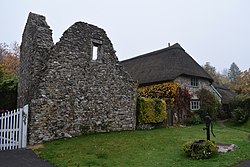Dunkeswell Abbey
| Dunkeswell Abbey | |
|
Devon | |
|---|---|
 Dunkeswell Abbey Gatehouse ruins beide a cottage | |
| Location | |
| Grid reference: | ST143107 |
| Location: | 50°53’22"N, 3°13’11"W |
| Village: | Dunkeswell |
| Order: | Cistercian |
| History | |
| Founded: | 1201 |
| Dissolved: | 1539 |
| Information | |
| Condition: | Ruins |
Dunkeswell Abbey is to be found two miles north of Dunkeswell village in Devon. Only its ruins remain, though the site has been partially reoccupied, with a Victorian church.
The site remains a remote location, with just a farm and little more. The abbey ruins are a scheduled ancient monument.[1]
The design of the buildings includes some unusual features. The remains left buried are extensive and relatively undamaged by subsequent activity. There are also the traces of fishponds used to provide a foodsource.
Hstory
The abbey was founded in 1201 by William Briwere as a Cistercian monastery and offshoot of Forde Abbey. The founder granted much property within Devon to the abbey. Around two years before his death in 1226, he entered the community himself and was eventually buried in front of the high altar of the abbey church. The history of the abbey is well documented.
As art of the Dissolution of the Monasteries, the abbey was closed in 1539. The land was granted to John Russell, 1st Baron Russell (1485–1555), later 1st Earl of Bedford.
Most of the abbey buildings were quickly demolished, though a section remained in domestic use until the 19th century.
In 1842, a parish church, Holy Trinity Church, was built over part of the site, in Early English style.
Some surviving fragments of monastery include the partial end wall of the cellarer's range and parts of a gatehouse. Some carved fragments survive within Holy Trinity Church.
Outside links
References
- ↑ National Heritage List 1009303: Dunkeswell Abbey ancient monument record